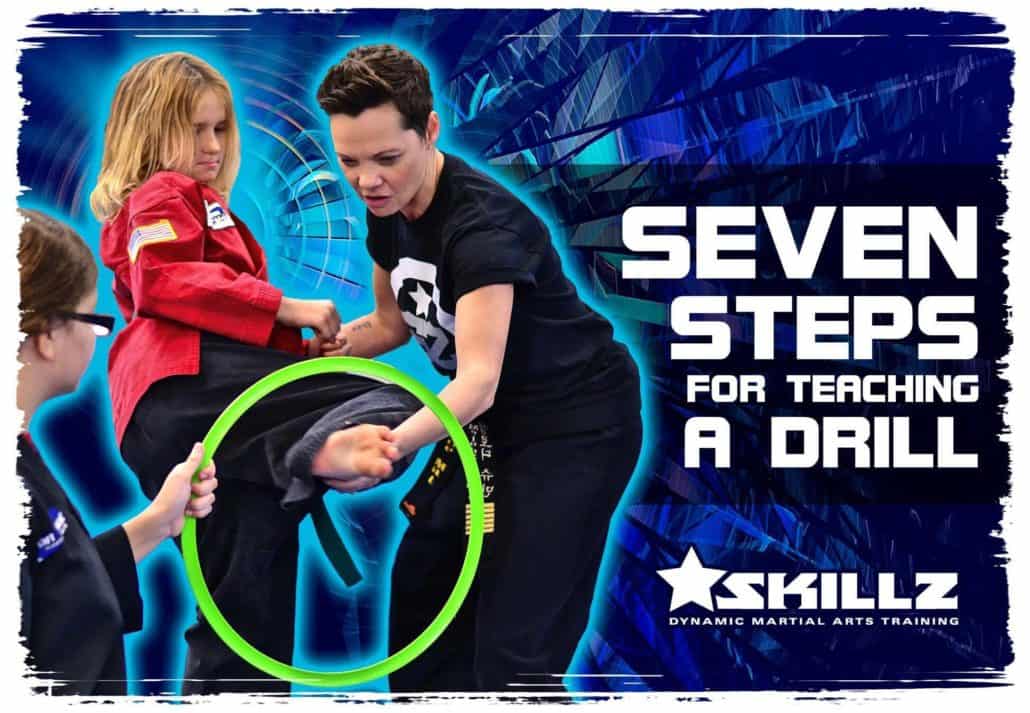Drills are the backbone of a quality Martial Arts class. At the same time, teaching a drill may seem easy but it does require skill if you want to generate the best results. The problem is an instructor can bring life to a drill, or death to it. Poor execution can lead to poor student development, or worse yet, boredom. With that said, it is always important to remember that teaching a drill is not only a way for you to test your students, but your teaching skills as well. To maximize the overall impact of a drill, it is important to follow some very important steps. To make your job easier, I have listed out each step and a few details on how to follow the steps properly.
Let’s get started!
Here are the seven steps for teaching a drill:
1. Set up the drill
It is important that you set up the lines and the equipment before you start to explain the drill. This makes the flow from one step to the next much smoother. With that said, it is also important that you set up the drill efficiently. If you are dividing the class into groups or lines, make sure you have a solid system for doing it quickly. At our school we have a system for dividing our class into pairs, lines, on one end of the mat, and into teams. For example: when we divide our class into pairs, we tell everyone to find a partner and line up facing each other across the middle of the mat in 10 seconds or less. This challenge gets them paired up quickly.
2. Name the drill
Make sure everyone knows the name of the drill. If there isn’t already a name for the drill, make-up one on the spot. This will help the students feel more of a connection to the drill. At our school, we have names for every drill. A few examples are: Dizzy Kicks, Pad Tag, Action Elimination, Spar Wars, etc.
3. Explain the drill
Properly explain the overview of the drill. Include all the proper details, but also try not to speak for too long. We also make sure that we have 1 to 3 key “takeaways” that we want to our student to focus on during the drills. For example: in Dizzy Kicks the 3 takeaways are 1) keep your hands up while you kick, 2) keep your head up while you kick, and 3) snap your knee while you kick.
4. Demonstrate the drill
Many students are visual learners so it is important to have a well-skilled assistant or student properly demonstrator the details of the drill. At our school, we like to demonstrate both the improper way to perform the drill and the proper way to perform the drill. Giving both examples helps clarify your expectations even more.
5. Start the drill properly
Use powerful words and enthusiasm to get the students pumped up as you begin the drill. This sets the mood and tone of the entire drill. At our school, we also like to use trickery when starting the drill to make sure everyone is paying attention. For example: our instructor will say something like: “On your marks… get set… goose!”
6. Instruct during the drill
Monitor the students’ abilities to perform the drill properly and make corrections when necessary. This also includes management of the students’ overall efforts. At our school, we like to multi-task while teaching the drill by correcting students while using healthy competition to point out who’s doing the drill correctly. For example: we will say something like “looks like the girls are snapping their knees more on their front kicks!”
7. Close the drill
Make sure you finish the drill on a high note. How you end the drill is equally as important as how you start the drill. At our school we like to point out one or two students that put forth great effort. Ending on this note has a two-fold benefit: 1) the people that are acknowledged get a confidence booster, and 2) the ones that didn’t get acknowledged reflect on what they will do better next time to increase the chance that they may be the ones that are pointed out.
As mentioned above, drills are the backbone of a quality Martial Arts class. It requires skill and a conscious effort in applying the steps from above. This does take a lot of practice, so be patient and mindful on your strong areas and the areas where you can work on improvement. Apply all seven steps properly and you have one of the key ingredients to a successful Martial Arts class.
P.S. Check out our Instructor Certification Course in the Events Section of this site to get more training on this topic!



